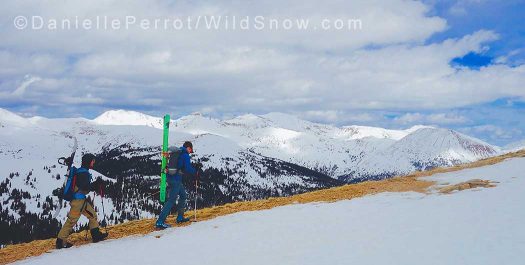Alex Dierker

A quick hike on Loveland Pass, Colorado. In about a hundred years — or sooner — this could be a lot different due to global warming. Photo: Danielle Perrot
Saturday April 8th, 2017
This last Saturday Dani and I did some human-powered skiing here in Colorado, at Loveland Pass and Arapahoe Basin. After the fun, we headed to the base lodge for a panel discussion on climate change, hosted by Protect Our Winters and A-Basin.
The discussion featured three “local” science experts: Dr. Jim White (Professor of Geological Sciences at CU Boulder, Director of the Institute of Arctic and Alpine Research), Dr. Katja Friedrich (Associate Professor of Atmospheric and Oceanic Sciences at CU Boulder), and Dr. Keith Musselman (Postdoctoral Fellow at the National Center for Atmospheric Research). The panel offered a rare opportunity to interact directly with three leading scientists involved in climate change research and work in our backyard here in Colorado.
The panel highlighted the scientists’ research that is being conducted on past, present and future climate change, the tools and technology, and a review of Climate Science 101. We have come a long way from taking photographs out of airplane windows to see what the snowpack looks like. Thanks to modern-day automated observation and satellite remote sensing, we have an incredible amount of information about our planet, which helps us to better understand its complexities.
As the panel explained, all of this data is used to run global climate and land surface models, which help scientists evaluate current and forecast future atmospheric conditions. These ever-evolving models run on supercomputers can now capture crazy small spatial scales, bringing into focus weather patterns around individual mountain peaks. Even with incredible computing speeds, these models can take years to set up and run a handful of climate change experiments. The result from this modeling is that now scientists can better understand how changes in greenhouse gases may alter ocean and air temperatures, precipitation, and mountain snowpack.
The fact of the matter is that our atmosphere is changing and changing at an alarming rate. It’s safe to say that those of us who read this blog regularly are highly in tune with the weather and even slight changes in the seasons. We enjoy the diverse mountain climate and the recreational activities that go along with it. Colorado alone has a multi-billion-dollar ski industry. Approximately 80% of our water supply comes from the snowpack, which helps us store that water until we really need it during the summertime. Let’s put it this way: we need the snow for our economy, health, and sanity.
The recent model results presented by the group included an outlook of precipitation, air temperature and mountain snowpack that would reflect a 4-degree Celsius increase in atmospheric global air temperature. This is a scenario predicted for the end of this century if population increases and we continue to produce emissions at today’s levels (i.e. “business as usual”). The maps of model-predicted snowpack reductions were sobering.
In short, Colorado could make out better than most thanks to our high elevation. At the peaks, future increases in winter and spring snowfall may partially offset more frequent shoulder-season rain, limiting snowpack losses. Much higher snow lines would mean 10-30% reductions in snowpack and much wetter snow. Like Colorado, the Canadian Rockies could potentially fare better than most because of its reliably cold air, but the Sierra, PNW and the Coastal Ranges of BC could lose a stunning 50-85% of their seasonal snowpack. The San Juan Mountains could see 20-30% reduction in snowfall and the Wasatch could see even bigger losses.
All in all, a very interesting panel discussion. It was great to see people from different sides of the community and country come together to discuss the issues at hand. The panel did a great job at explaining some science basics (like what is the difference between weather and climate, or how does our atmosphere work) and answering questions from the audience. Also, it was great to hear about future plans from A-Basin as they move to increase their use of solar and make their base area more environmentally friendly. We are starting to see more and more of these types of gatherings happen around the ski community and I highly recommend you stop in and check one out!
As for WildSnow, we’ve had quite a bit of interesting discussion about climate change, more always welcome.
Beyond our regular guest bloggers who have their own profiles, some of our one-timers end up being categorized under this generic profile. Once they do a few posts, we build a category. In any case, we sure appreciate ALL the WildSnow guest bloggers!

